
How To Grow Magic Mushrooms In A Monotub
There are numerous ways to grow magic mushrooms at home. Perhaps the easiest way to grow in bulk is with a monotub. Read on to find out what you need to know to ensure a successful monotub grow.
More and more people are realising that it’s quite possible to grow psychedelic fungi at home! Not only does the home cultivation of magic mushrooms give you a ready supply of psilocybin, but the process can be incredibly interesting too.
If you search for growing methods, you’ll discover that there are many out there. In this article, we look at growing magic mushrooms using a monotub—an easy and reliable way to grow in bulk.
What is a monotub?

A monotub is a container in which a substrate can both colonise and fruit. With a monotub, you must colonise grain to make a grain spawn (you’re best off doing this in a grow bag), then you use this to colonise the monotub and create a bulk grow.
The grain spawn will go on to quickly colonise the substrate in the monotub, from which a large harvest of magic mushrooms will grow!
Why grow in a monotub?
Monotubs are great because they make the process of growing mushrooms at once easy and productive. If you want to grow large amounts of shrooms with as few steps as possible, then a monotub is definitely your best bet.
They are easy to make, and maintaining your grow inside them is equally easy.
How to grow magic mushrooms in a monotub

Growing shrooms in a monotub setup is fairly straightforward, but you’ll still need to be careful throughout the process, as it’s not immune to contamination and the mycelium and mushrooms still require a specific environment to grow.
In the following section, we’ll explain how to grow magic mushrooms in a monotub.
Equipment
- Spore syringe/liquid culture
- Grow bag/jar containing a grain substrate
- Monotub
- Spray/misting bottles
- Disinfectant
- Sterile gloves
- Flame source
- Monotub substrate
- Rockwool
Optional extras
For better results, you can also use:
- A heat source (mats or a heater)
- Thermometer and hygrometer
- Fan
- Still air box
Shroomshop
Zamnesia's Shroomshop stocks a wide variety of magic truffles, mushroom growing kits, spore prints, and more.
Make or buy monotub?

If you don’t already have a monotub, you’ll need one!
While you can buy them, we’d really recommend making your own, as they’re very easy to make, and this will be a lot cheaper.
Prepare your grow
Before you start inoculating, the first step in any mushroom grow is to clean! Wipe down surfaces with disinfectant, clean your hands, don your sterile gloves, and consider wearing a face mask too.
If you can, you should inoculate inside a still air box (SAB), or even a laminar flow hood, although a SAB is a much better option for beginners. These devices control the flow of air and significantly reduce the risk of contamination when inoculating.
That being said, if you use a grow bag with a self-healing injection port, rather than a jar, then you’re in much better stead anyway.
Inoculate spawn bag
Once everything is clean, you’re ready to inoculate.
First, hold your syringe’s needle in a flame until it is red hot—this will sterilise it. Let it cool before inoculating.
Now, push the needle through the injection port on your grow bag or jar. If using micropore tape rather than a self-healing injection port, cover the hole with another strip as soon as you remove the needle.
Around 5ml of spore solution or liquid culture should suffice.
Leave your bag to colonise. The ideal temperature is 28ºC.
Make a monotub substrate

For growing Psilocybe mushrooms, an ideal mixture is 50% coco coir and 50% horse manure. If you’d like, you could also make around 10% of this mixture vermiculite, to help regulate humidity.
The substrate mix should be sterilised prior to being used. There are two ways to do this:
- Steam: Wrap the substrate in something heat resistant (such as aluminium foil) and steam it for around an hour.
- Oven: Alternatively, you can cook it in a baking tray for 2.5 hours at 170ºC.
In either case, it should be moist, without being soaked, afterwards. If you need to rehydrate it, make sure to use sterilised water. To judge whether the substrate is appropriately moist, squeeze a handful tightly. If a small amount of water drips out, then it is about right.
Colonise your monotub
Once your grain spawn is fully colonised, you can transfer it to your monotub. To do this, add a layer of substrate to your monotub. Then, sprinkle in a layer of grain spawn. Repeat this process until all of the grain spawn is used up. There should be around 15cm of free space remaining at the top.
Let the monotub colonise
Now, you need to let the monotub colonise.
While colonising, you should maintain a temperature of 28ºC. With the lid of the monotub sealed, it should maintain its humidity while colonising, if the substrate was moist enough to begin with. Keep all holes plugged during this process, as you want high levels of CO₂.
Fruiting and harvesting

Once the substrate is fully colonised, unplug the holes. The upper holes should be left totally open, while the lower ones should be plugged with a semi-permeable membrane, which will allow air through but catch contaminants. Rockwool can work well.
Once the mushrooms begin to grow, the temperature should sit between 23 and 28ºC, and humidity should remain high—around 90–95%. To achieve this, mist the walls of the box once or twice a day, depending on how warm and dry the surrounding room is. Also, take the lid off the box at least once a day and fan it; this helps to get fresh air into the box, replenishing oxygen.
Alternatively, setting up a fan in the grow space can help to circulate air, which will increase air exchange through the holes in the monotub. The fan should blow away from the box.
Mushrooms, once they appear, should only take a couple of days to reach maturity.
The key when harvesting is to pick them before the veils drop! The veil is the membrane on the underside of the cap that contains the spores. If the veil splits, spores will pour out onto your substrate, which tells the mycelium that its reproductive job is done and it can stop producing mushrooms. Given that your monotub is capable of producing several flushes, you don’t want this to happen.
To harvest mushrooms, twist them by the stem and they should come away easily. Then, you’ll need to dry and store them.
Make the most of mycelium with a monotub

Using a monotub is probably the easiest way to grow a large quantity of magic mushrooms at home. From making one yourself to growing mushrooms in it, the process isn’t all that difficult; it just requires some careful work and a clean approach!
But if you want to grow magic mushrooms at home in bulk, then this is the way to go!
-
 5 min
15 November 2024
How to Build Your Own Monotub and Grow Mushrooms in Bulk
There are many ways to grow magic mushrooms, and for the biggest yields, you can't really do better than a monotub! Quick, easy, and very productive, find out how to make one here.
5 min
15 November 2024
How to Build Your Own Monotub and Grow Mushrooms in Bulk
There are many ways to grow magic mushrooms, and for the biggest yields, you can't really do better than a monotub! Quick, easy, and very productive, find out how to make one here.
-
 6 min
7 February 2023
How To: Injection Port Lids & Bags For Mushroom Cultivation
Keeping contaminants out of your jars and spawn bags is essential when growing magic mushrooms. Using self-healing injection ports is a very effective means to help you on your quest for...
6 min
7 February 2023
How To: Injection Port Lids & Bags For Mushroom Cultivation
Keeping contaminants out of your jars and spawn bags is essential when growing magic mushrooms. Using self-healing injection ports is a very effective means to help you on your quest for...
-
![How To Grow Magic Mushrooms Indoors [3 Methods]](https://www.zamnesia.com/uk/modules/prestablog/themes/responsive/up-img/slide_2060.jpg?fc662b267fa1db02d0875650f245cfe0) 5 min
22 February 2022
How To Grow Magic Mushrooms Indoors [3 Methods]
Growing magic mushrooms at home needn't be difficult. Here we look into three different growing methods, ranging from the beginner-friendly to the advanced. Whichever one you choose, big, healthy...
5 min
22 February 2022
How To Grow Magic Mushrooms Indoors [3 Methods]
Growing magic mushrooms at home needn't be difficult. Here we look into three different growing methods, ranging from the beginner-friendly to the advanced. Whichever one you choose, big, healthy...
-
 7 min
3 September 2021
How To Make A Laminar Flow Hood For Mushrooms
Often find mould growing in your substrate where there should be mycelium—even though you've cleaned everything with alcohol and bleach? Well, things float on the air. To create the ultimate...
7 min
3 September 2021
How To Make A Laminar Flow Hood For Mushrooms
Often find mould growing in your substrate where there should be mycelium—even though you've cleaned everything with alcohol and bleach? Well, things float on the air. To create the ultimate...
-
 4 min
11 December 2020
Sterile Technique For Growing Magic Mushrooms
Growing mushrooms is a magical experience, but things can sometimes go wrong. Floating microbes can easily contaminate mushroom cultures when they're exposed to the open air. Use these tips and...
4 min
11 December 2020
Sterile Technique For Growing Magic Mushrooms
Growing mushrooms is a magical experience, but things can sometimes go wrong. Floating microbes can easily contaminate mushroom cultures when they're exposed to the open air. Use these tips and...
-
 4 min
17 September 2020
What Is Mycelium In Magic Mushroom Cultivation
If you've been looking into growing your own magic mushrooms, we're guessing you've seen the term "mycelium" come up in articles and forum discussions. Like a lot of concepts surrounding magic...
4 min
17 September 2020
What Is Mycelium In Magic Mushroom Cultivation
If you've been looking into growing your own magic mushrooms, we're guessing you've seen the term "mycelium" come up in articles and forum discussions. Like a lot of concepts surrounding magic...








 United States
United States














